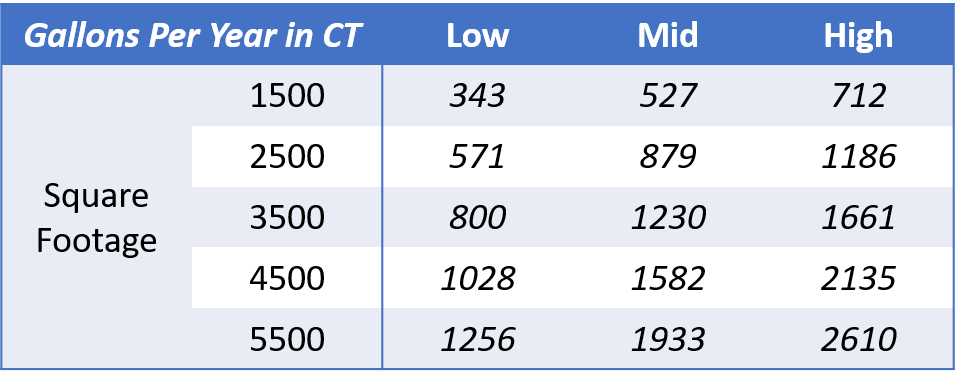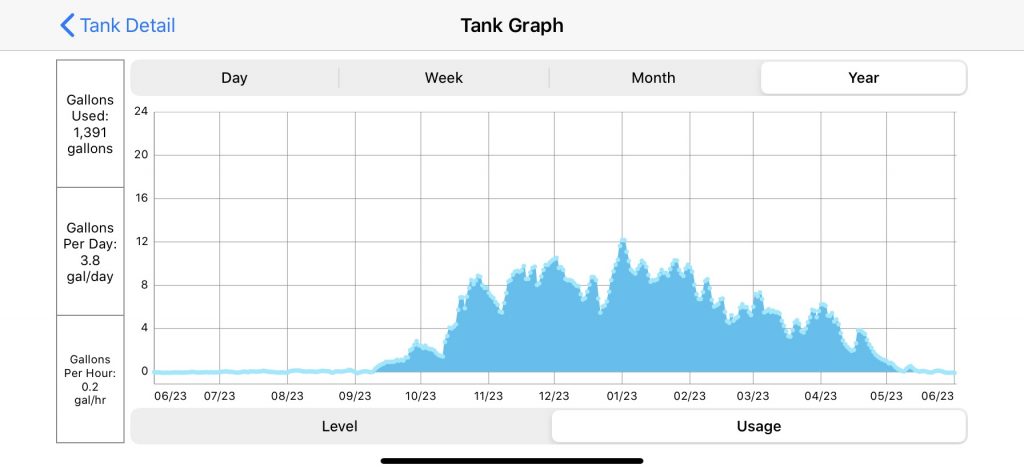If you live in the northeast, you are probably aware that heating oil is one of the most common sources for fuel to heat our homes. Heating oil is used not only for heat, but also for hot water in many homes. Unlike natural gas or electricity, heating oil must be delivered occasionally to a tank at the house.
One of the nice things about home heating oil is that if you run out, you can always go and grab 5 or 10 gallons of diesel from your local gas station to keep the heat on until you can get a delivery. If you’ve never been in this position, just simply pour some diesel fuel into the fill pipe outside the house, restart the burner, and you should be good to go! The question many people ask though, is “how long will 5 gallons of heating oil last?”
The answer depends on a variety of factors, but on a typical winter day, in an average-sized house, you can expect 5 gallons to last up to a day. On an extremely cold day, your house may go through 10 or more gallons, so it’s important to make sure you don’t run out of home heating oil. To determine how long 5 gallons of heating oil will last in your house, take the following considerations into account:
- Is your home heating oil used for heat, hot water, or both?
- How big is your house?
- How well-insulated is your house?
- How drafty are your windows?
- What temperature do you keep the inside of your house?
- What is the outside temperature?
- Is your burner/furnace/boiler in good condition?
Heating Oil for Hot Water Heaters
Hot water heaters generally run on heating oil, propane, natural gas, or electricity. If yours runs on heating oil, then you’ll want to make sure to check your heating oil tank periodically throughout the summer to prevent a runout. Fortunately, hot water heaters do not use nearly as much heating oil as your furnace or boiler will when heating the entire house.
Expect an average daily usage of 0.5 to 1.0 gallons of heating oil to keep the water hot. If you have a larger house, or an instant hot water recirculating pump that constantly moves the hot water throughout the house, expect your consumption to be on the higher end of the range.
Heating Oil For Heating Your House
When heating your house with heating oil, you can obviously expect to use more heating fuel oil in the coldest months of the year. This is because the cold outside air is constantly removing the heat from your house through the windows, walls, and roof. As this heat transfer occurs, the furnace or boiler has to work overtime to keep the inside of the house warm.
Daily heating fuel oil consumption can range from 1-2 gallons on a warm winter day in a smaller house, to 10-20 gallons on a really cold day in a large house! Below is an approximate look at how many gallons of heating fuel oil will be used to heat a house of a given size depending on the outside temperature.
How The Temperature Outside Affects Home Fuel Oil Usage
In Connecticut, where the average temperature in December is around 30° F, a typical 2500 square foot home will use approximately 4-6 gallons of heating fuel oil per day. Looking at the table below, if the lows are around 20 and the highs are around 40, then 5 gallons may last you up to a day while you are waiting for a home heating oil delivery. If you are trying to conserve heating oil, make sure to turn the thermostat down a few degrees until the truck comes. This will reduce your consumption while you are waiting for your oil tank to be filled.

With this in mind, you may be wondering “how much heating oil will I use in a year?” Based on a typical 12 months in Connecticut, we’ve put together the following estimates for heating oil usage in CT. If your home is very well-insulated, or you have an auxiliary heat source (such as a wood burning stove), you may be at or below the low end of these estimates. That said, if you have a poorly insulated house, or you keep the inside of the house particularly warm all winter, you may be off the chart to the right. The average size home in CT can expect to burn approximately 880 gallons of heating oil per year.

Heating Fuel Oil for Heat and Hot Water
If you use heating fuel oil for both heating and hot water, you will want to increase those estimates in the table above by 0.5 to 1.0 gallon per day. The more people in the house having hot showers, the more heating oil you can expect to use to heat the water.
Proper Insulation Can Help Conserve Home Heating Oil
It goes without saying, but a better-insulated home will do a better job of keeping the warm air in, and the cold air out of your house. If you have an older house with no insulation, you should consider performing an energy audit to see where you can most improve your home’s ability to retain heat. Blown-in insulation is a great option that can help keep the heat in.

Drafty Windows Can Increase Heating Oil Consumption
Another major factor for heat loss is the quality and type of windows in your home. Older, single-pane windows will result in much more heat loss than newer double-pane windows. With double-pane windows, the air trapped between the two windowpanes will act as insulation and do a much better job of keeping the warm air in.
Since replacement windows can be rather costly, an interim method for conserving heating oil is to locate drafty windows and seal them the best you can. There are thin plastic sheets that can be adhered to the window frame using double-stick tape. Applying a hairdryer to the sheet once it has been cut to size and installed will cause any wrinkles in the sheet to disappear, making the sheet nearly invisible. The result is that there is no longer any air flowing through the window, and there is now a nice air pocket to act as insulation between the cold outside air and the warm inside air.

Program Your Thermostat to Conserve Heating Oil
In the winter months, keeping the thermostat at a comfortable setting leads to endless debates among family members. If your parents never told you to put on an extra layer as a kid, then you were one of the lucky ones! Keeping the thermostat between 65 and 70 is usually sufficient for most homes to be comfortable. If the heat is not very consistent throughout your home, you may find yourself adjusting the thermostat up or down accordingly until the family room is a comfortable temperature.
You may be wondering, “should I turn the heat down when I leave the house during the day?” This can have a considerable impact on your heating fuel oil consumption, so it is important to think about. The answer though, is that it depends on how your house is heated. If your house has a boiler, with radiators throughout the house, then it can take quite a while to raise the temperature a few degrees. As a result, you may actually burn more oil re-heating the house at the end of the day if you opt to do this. That said, if your house has forced hot air (air ducts are placed throughout the house to allow warm air from the furnace to circulate throughout the house), then your house will heat very quickly. As a result, it’s often okay to turn the heat down 5-10 degrees each morning when you leave. This allows the furnace to burn less fuel throughout the day while nobody is home. You can program your thermostat to turn the temperature back up about an hour before you arrive, and the home will usually be up to temperature by the time you arrive. If you have a Smart Oil Gauge, you will be able to monitor your hourly usage throughout the day to determine the best approach for your house leaving you with more heating fuel oil in your oil tank.
Keep Your Burner/Furnace/Boiler in Top Condition
Regardless of how good a job you do insulating your walls and sealing up drafty windows, an old inefficient furnace will still be an old inefficient furnace at the end of the day. Make sure you have your system tuned up at least every two years, and best case, every year. This will insure it is in good condition and working as efficiently as possible. While oil burners can often last as long as 30 years or more, it is important to check for cracks in the heat exchanger to make sure you do not end up with exhaust gases entering the house. As these systems age, their efficiency can go down too, and you end up using more heating oil than in years past. A new system can pay dividends in reducing the amount of oil needed to heat your home.
Summary: How Long Will 5 Gallons of Heating Oil Last?
While everything above should serve as a good guideline for how long 5 gallons of heating oil will last, the best way to determine how long it will last in your house is to actually measure it! The best way to measure your heating oil usage is with a Smart Oil Gauge. The Smart Oil Gauge uses an ultrasonic sensor to measure the level in the oil tank all throughout the day. With this type of data, you no longer have to ask, “How much heating oil is in my tank”, and you can look at a whole year’s worth of data to determine your burn rate throughout the year. In the image below, taken from the Smart Oil Gauge app, you can see the ‘Gallons Per Day’ for a house in CT. You’ll see that in the summer months, this house does not use any oil (heating oil is used for heat only in this house).
You’ll also see that the peak usage was around 12 gallons per day in late January, 2020. If you recall, the beginning of January, 2020 was one of the warmest on records, and we can see this in the usage data below! The Smart Oil Gauge also gives a summary of total gallons used (1,391), and an average annual usage of 3.8 gallons per day.

A Smart Oil Gauge can be one of the best investments to make to determine how long 5 or 10 gallons of heating oil will last. You can also utilize the data from the Smart Oil Gauge to see how improvements to your windows, insulation, or furnace/boiler impact your overall oil usage.
Happy heating,
Steve



